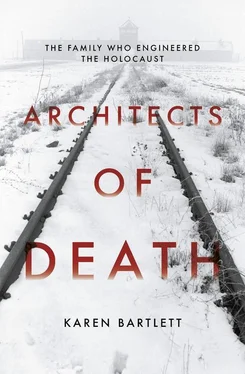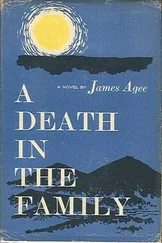At 5.30 a.m. on the morning of 31 May, Ludwig’s lover Ursula Albrecht woke Max Machemehl (who was also living in a house in the Topf family park) to tell him that ‘Ludwig has gone!’ Albrecht was overcome with emotion and proceeded to run around the park crying. In the midst of all the chaos, Machemehl got dressed and drove over to tell Ernst Wolfgang Topf the news. He recalled that ‘shortly afterwards, Fräulein Albrecht arrived in the Daberstedt Strasse in the CIC [American Counter Intelligence Corps] car and screamed that L. had been found dead near the roofing felt store.’ [115] Ibid., p. 248. Machemehl’s account of the suicide. AS footnote 31: Handwritten report by Machemehl (Ma), 31.5.1945, ThHStAW, J. A. Topf & Söhne Nr 427, sheets 244f; Collection Jean-Claude Pressac Nr 34, sheets 212f.
Max Machemehl found Ludwig’s farewell letter and passed it to the CIC. In keeping with Ernst Wolfgang’s narrative that Ludwig’s death was due to a personal matter, family doctor, Dr Karle, ruled that it was a case of suicide ‘brought on by war-induced nervous shock’.
Above all, Ernst Wolfgang was determined to protect the family business, and his own fortune, by ensuring that Topf and Sons resumed production. In the early days of the American occupation, this seemed quite plausible. As far as Topf could see, the American investigation was going nowhere and the CIC seemed to accept the company line that Topf and Sons had spent the war conducting ‘perfectly ordinary business’. Even Ludwig Topf’s suicide appeared hasty when Kurt Prüfer was released from arrest on 13 June 1945, and went back to work at Topf and Sons. Those responsible, however, would have much more to fear from the Soviet forces, who would assume control of Erfurt and the surrounding area as part of the Soviet zone of occupied Germany.
With production at standstill, and the company still owed large amounts of money for aircraft parts it had produced for the Luftwaffe, Ernst Wolfgang Topf’s most pressing problem was how to get his hands on a large life insurance policy for 300,000 RM which he could now claim after his brother’s death. To do this, however, he had to travel to the Allianz insurance company in Stuttgart – something which required permission from the occupying government. On 13 June Ernst Wolfgang and his newly appointed deputy, Kurt Schmidt (formerly head of Department E for silo and storage construction) were granted permission to travel. Topf left Erfurt with his wife and daughter on 21 June and headed first to Wiesbaden, where his son was living with his in-laws. Once there, however, he was refused permission into the French occupied zone around Stuttgart. He then fell ill.
While Ernst Wolfgang was away, there was tumultuous change at Topf and Sons, as well as in Erfurt itself. One day after his departure, the American military informed Topf and Sons that they could resume production for systems related to foodstuffs and were allowed to employ fifty people – an announcement greeted with joy at the company, as a note in the file reflects: ‘Sender: Military Government Erfurt. Content: Permission to resume Production. GREAT JOY!!!!!!!!!!!!’ [116] Ibid., pp. 254–5. Topf to resume production memo. AS footnote 64: Military Government of Germany Erfurt, 22 June 1945, ThHStAW, Collection Jean-Claude Pressac Nr 80, sheet 66. AS footnote 65: Post list 21.6.-3.9.2945, sheet 2, ThHStAW, Collection Jean-Claude Pressac Nr 80, sheets 92–4. AS footnote 66: A letter from Kurt Schmidt to Ernst Wolfgang Topf includes the following: ‘The New Production permit relates to the Malting, Silo and Mill construction departments, excluding furnace systems. We can of course continue to carry out repairs to furnace systems.’ Kurt Schmidt to E. W. Topf, 18 July 1945, ThHStAW, Collection Jean- Claude Pressac Nr 80, sheet 77. AS footnote 67: File note, operations division, Braun, 11 October 1945, ThHStAW, Collection Jean-Claude Pressac Nr 80, sheet 117.
Although furnace construction was excluded from the notice, the first order was for a crematorium oven for the city of Erfurt.
Ernst Wolfgang’s absence, however, made the leadership of the company uncertain – with many questioning whether he ever planned to return, especially after the announcement on 3 July that Erfurt would be transferred from American to Soviet control (as had already been agreed by the Allies in September 1944). On 18 July Kurt Schmidt wrote to Topf: ‘I don’t want to write down here the rumours that are circulating in Erfurt about your absence… but it would be very important for you to be here if you could.’
The change of control to a Soviet occupying force was one that Ernst Wolfgang had feared, and he had tried to seek assurances before his departure that it would not happen during his trip. However, it was clearly something beyond his control, and Topf now found himself in limbo – he had left Thuringia and was now unable to return. At the end of July Ernst Wolfgang was denied permission to re-enter the Soviet zone. He spent several months holed up in a schoolhouse near the border, while he petitioned to be allowed to return to Erfurt. When the new school year started in September, he moved in with his sister Hanna’s daughter near Kassel for six weeks – but his efforts to return to Topf and Sons remained fruitless. Although Ernst Wolfgang was doing everything in his power to facilitate a return to Erfurt, he also used this time to lay what he hoped were the foundations for a new Topf and Sons in West Germany – building on the company’s existing network of branch offices. While he continued to urge loyal employees like Kurt Schmidt to fight the expropriation of the company in Erfurt, he also urged them to join him in the west if those efforts were unsuccessful.
In the immediate aftermath of the handover from American rule, the Soviets wasted no time in assessing what role Topf and Sons could help play in rebuilding the Soviet economy – they also continued to make less overt enquiries into the links between Topf and Sons and the Nazi concentration camps.
In July 1945, the first month of Soviet rule, officers visited Topf and Sons on five occasions. Their first visit was to establish the size of the company, its production system and the raw materials that were being used. Officers were also keen to find out what had happened to an order for vertical kilns that had been destined for the Soviet Union, but which had been cancelled after the German invasion of 1941. They were mainly concerned with the food systems aspect of the business – including the possibility of producing field kitchens for the USSR (which was in fact the subject of a very large order in October that year).
At the same time Soviet officer Major Kriwenzow saw his visit to Topf and Sons as an opportunity to probe further about why Ludwig Topf had committed suicide. Kurt Schmidt, Gustav Braun and other representatives of the company’s management reassured Kriwenzow that Ludwig’s death had had nothing to do with the company’s relationship with the SS. ‘The radio advertisement about the cremation ovens at Buchenwald can be ruled out as a significant factor, since we all knew that these were a perfectly normal order,’ the Topf minutes state. The record goes on to claim, untruthfully, that these ovens were based on a 1911 design, and that they were the same as those supplied all over the world, including the USSR. The Topf management seem reassured that Major Kriwenzow shares their view: ‘Major Kriwenzow said that it was the view of the Russians that the supplying company could not be held in any way responsible for the cremation ovens, since so far as the company was concerned, it was a delivery just like any other.’ Kurt Schmidt agrees, adding that if one was to take the opposite view, and hold Topf responsible for the atrocities committed in the camps, you would also have to hold responsible every other tradesperson, including ‘table makers, stool makers and cupboard makers’. [117] Ibid., pp. 256–7. Archive note about Major Kriwenzow. AS footnote 76: Wiederinbetriebssetung [Resumption of production], 12.9.1945, ThHSt- AW, Collection Jean-Claude Pressac Nr 80, sheets 98–100.
Читать дальше












